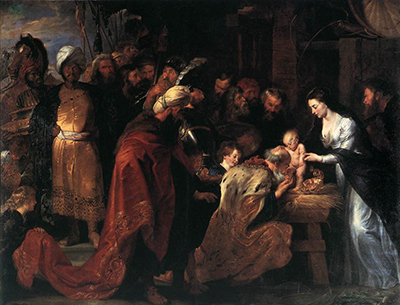Peter Paul Rubens took on individual Christian themes on multiple occasions, but none more so than his series of four depictions of the Adoration of the Magi
The two versions of Annunciation are highly respected, but in the case of Adoration of the Magi there are now four supreme works scattered around prestigious European art galleries. Each one deserves respect and artistic study in its own right but this page focuses specifically on the version which can now be found in Lyon, France.
Rubens produced this one in circa 1617-1618 whilst the other three can be found in Madrid (1609, 1628-1629), Cambridge (1616-1617) and Antwerp (1624). Its exact location in Lyon is the Museum of Fine Arts (Musée des Beaux-Arts de Lyon) which contains a fine selection of paintings from the Early Renaissance all the way up to the present day.
Those taking the time to visit the original painting in the Museum of Fine Arts in Lyon can also expect to see famous paintings by the likes of Rembrandt, Jean Auguste Dominique Ingres, Théodore Géricault, Eugène Delacroix and Gustave Courbet. Their collection of impressionist and post-impressionist work inclue Edouard Manet, Pierre Auguste Renoir, Edgar Degas, Claude Monet and Vincent van Gogh.
The style of this work is typically that of Rubens, dark scenes with a powerful spread of light across the canvas which brings the key elements into focus. Only Caravaggio and Rembrandt can claim to be as famous for their use of dramatic lighting as this Flemish master. The approach can be seen again and again throughout his career, most notably in Descent from the Cross and Samson and Delilah.
The composition places twelve full-length male figures that cover the full width of the canvas. The main focus of the painting is on the Virgin Mary and the baby Christ. The extreme lighting helps to intensify the atmosphere as well as signifty clearly where the balance lies in importance.
Adoration of the Magi, or Kings as sometimes termed, can be seen throughout the Renaissance and Baroque periods, far beyond just the work of Rubens. Albrecht Durer, Diego Velazquez, Giorgione, Diego Velazquez and Leonardo da Vinci are amongst the other significant names to have covered this iconic scene.
Rubens achieved great notoriety within his own lifetime and was rewarded with regular commissions both for institutions as well as private individuals. It is believed that this artwork was a private commission because of its aspect ratio, as a landscape shape rather than portrait. His altarpiece work would instead tend to be portrait shaped.
The great masters of the Renaissance and Baroque eras were, in some cases, highly skilled at making the most of their reputation, financially. Traditionally, artists have been seen as economically naive but the most famous have been able to generate huge incomes from reproductions of their original work through engavings, woodcut prints and more. Rubens even produced tapestries based on paintings such as Adoration of the Magi found here.




